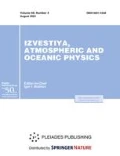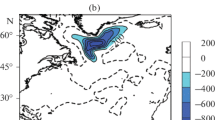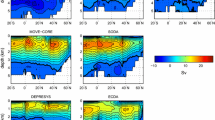Abstract
Zonally averaged characteristics of the North Atlantic (NA) thermohaline circulation are investigated in different phases of the Atlantic Multidecadal Oscillation (AMO) index over the past 70 years using ocean objective analyses EN4 and WOA13 and reanalyses GFDL, ESTOC, ORA-S4, and GECCO2. It is shown that similar thermohaline patterns appear in zonally averaged climatic trends and in differences in the composites of anomalies of the potential temperature and salinity fields for all data sets. To find out how the variability in the thermohaline state of waters in the NA is accompanied by the variability in its thermohaline circulation, we have analyzed the variability of the Atlantic Meridional Overturning Circulation (AMOC) stream function. The average AMOC stream functions calculated from ocean objective analyses and reanalyses, reflecting the NA thermohaline circulation, are generally similar to each other. Nonetheless, they can be divided according to their spatial structure into two groups: (EN4, WOA13, and GFDL) and (ESTOC, ORAS4, and GECCO2). In their trends and anomaly composite differences, the AMOC stream functions differ significantly among themselves, as well as from EN4 and WOA13. Moreover, the main distinction is in the sign of climatic trends and composite differences, which determines changes in the direction of the zonally averaged thermohaline circulation. It is found that positive and negative temperature (salinity) anomalies in alternating successive phases of the AMO index circulate with a period of roughly 60 years along the pathway of water in the AMOC, sinking into deep ocean layers at about 60° N and rising toward the surface at 25° N. This process is most pronounced for the EN4 and WOA13 objective analyses and ORAS4 reanalysis. It can be assumed that this mechanism contributes substantially to the formation of the AMO index phases.




Similar content being viewed by others
Notes
Note that the start and end dates of the winter (January, February, and March) and summer (July, August, and September) periods are usually shifted one month ahead of the calendar dates.
REFERENCES
M. E. Schlesinger and N. Ramankutty, “An oscillation in the global climate system of period 65–70 years,” Nature 367, 723–726 (1994).
R. A. Kerr, “A North Atlantic climate pacemaker for the centuries,” Science 288, 1984–1985 (2000).
D. B. Enfield, A. M. Mestas-Nuñez, and P. J. Trimble, “The Atlantic multidecadal oscillation and its relation to rainfall river flows in the continental U.S,” Geophys. Res. Lett. 28 (10), 2077–2080 (2001). https://psl.noaa. gov/data/timeseries/AMO/.
V. Gouretski and F. Reseghetti, “On depth and temperature biases in bathythermograph data: development of a new correction scheme based on analysis of a global ocean database,” Deep-Sea Research I 57, 812–834 (2010). https://www.metoffice.gov.uk/hadobs/en4/.
J. R. Knight, C. K. Folland, and A. A. Scaife, “Climate impacts of the Atlantic multidecadal oscillation,” Geophys. Res. Lett. 33, L17706 (2006).
G. N. Panin, N. A. Dianskii, I. V. Solomonova, A. V. Gusev, and T. Yu. Vyruchalkina, “Assessment of climate changes in the Arctic in the 21st century using a combined prognostic scenario,” Arkt.: Ekol. Ekon. 2 (26), 35–52 (2017).
G. N. Panin and N. A. Diansky, “On the correlation between oscillations of the Caspian Sea level and the North Atlantic climate,” Izv., Atmos. Ocean. Phys., 50 (3), 266–277 (2014).
A. Timmermann, M. Latif, R. Voss, and A. Grotzner, “Northern hemispheric interdecadal variability: A coupled air–sea mode,” J. Clim. 11, 1906–1931 (1998).
J. Knight, R. Allan, C. Folland, et al., “A signature of persistent natural thermohaline circulation cycles in observed climate,” Geophys. Res. Lett. 32, L20708 (2005).
A. B. Polonsky, “Interdecadal variability in the ocean–atmosphere system,” Russ. Meteorol. Hydrol., No. 5, 37–44 (1998).
A. B. Polonskii, “Atlantic multidecadal oscillation and its manifestations in the Atlantic–European region,” Phys. Oceanogr. 18 (4), 227–236 (2008).
E. N. Voskresenskaya and A. B. Polonskii, “Low-frequency variability of hydrometeorological fields and heat fluxes over the North Atlantic,” Phys. Oceanogr. 14 (4), 203–220 (2004).
R. G. Williams, V. Roussenov, D. Smith, and M. S. Lozier, “Decadal evolution of ocean thermal anomalies in the North Atlantic: The effects of Ekman, overturning, and horizontal transport,” J. Clim. 27, 698–719 (2014).
C. Wang, S. Dong, and E. Muñoz, “Seawater density variations in the North Atlantic and the Atlantic meridional overturning circulation,” Clim. Dyn. 34, 953–968 (2010).
E. M. Volodin, “The nature of 60-year oscillations of the Arctic climate according to the data of the INM RAS climate model,” Russ. J. Numer. Anal. Math. Modell. 33 (6), 1–9 (2018).
E. M. Volodin, E. V. Mortikov, S. V. Kostrykin, et al., “Simulation of modern climate with the new version of the INM RAS climate model,” Izv., Atmos. Ocean. Phys. 53 (2), 142–155 (2017).
L. M. Frankcombe and H. A. Dijkstra, “The role of Atlantic–Arctic exchange in North Atlantic multidecadal climate variability,” Geophys. Res. Lett. 38 (16), L16603 (2011).
E. M. Volodin, “The mechanism of multidecadal variability in the Arctic and North Atlantic in climate model INMCM4,” Environ. Res. Lett. 8 (3), 035038 (2013).
T. Delworth, S. Manabe, and R. J. Stouffer, “Interdecadal variations of the thermohaline circulation in a coupled atmosphere–ocean model,” J. Clim. 6, 1993–2011 (1993).
N. A. Diansky and V. A. Bagatinsky, “Thermohaline structure of waters in the North Atlantic in different phases of the Atlantic multidecadal oscillation,” Izv., Atmos. Ocean. 55 (6), 628–639 (2019).
R. A. Locarnini, A. V. Mishonov, J. I. Antonov, et al., World Ocean Atlas 2013, Vol. 1: Temperature, Ed. by S. Levitus, NOAA Atlas NESDIS (Silver Spring, Md., 2013), Vol. 73, pp. 1–40.
M. M. Zweng, J. R. Reagan, J. I. Antonov, et al., World Ocean Atlas 2013, Vol. 2: Salinity, Ed. by S. Levitus, NOAA Atlas NESDIS (Silver Spring, Md., 2013), Vol. 74, pp. 1–39.
IPCC Climate Change 2013: The Physical Science Basis. Contribution of Working Group I to the Fifth Assessment Report of the Intergovernmental Panel on Climate Change, Ed. by T. F. Stocker, D. Qin, G.-K. Plattner, (Cambridge Univ. Press, New York, 2013).
L. Caesar, S. Rahmstorf, A. Robinson, et al., “Observed fingerprint of a weakening Atlantic Ocean overturning circulation,” Nature 556, 191–196 (2018).
N. A. Dianskii, Ocean Circulation Modeling and Study of Its Response to Short-Period and Long-Period Atmospheric Impacts (Fizmatlit, Moscow, 2013) [in Russian].
S. Zhang, M. J. Harrison, A. Rosati, and A. T. Wittenberg, “System design and evaluation of coupled ensemble data assimilation for global oceanic climate studies,” Mon. Weather. Rev. 135 (10), 3541–3564 (2007).
S. Osafune, S. Masuda, N. Sugiura, and T. Doi, “Evaluation of the applicability of the Estimated State of the Global Ocean for Climate Research (ESTOC) dataset,” Geophys. Res. Lett. 42 (12), 4903–4911 (2015).
M. A. Balmaseda, K. Mogensen, and A. Weaver, “Evaluation of the ECMWF ocean reanalysis ORAS4,” Q. J. R. Meteorol. Soc. 139 (674), 1132–1161 (2013).
A. Köhl, “Evaluation of the GECCO2 ocean synthesis: Transports of volume, heat and freshwater in the Atlantic,” Q. J. R. Meteorol. Soc. 141 (686), 166–181 (2015).
A. R. Gorbushkin and A. N. Demidov, “Variability of thermohaline characteristics at 26.5° N in reanalyses and oceanographic section data,” Russ. Meteorol. Hydrol. 44 (7), 474–483 (2019).
T. J. McDougall and P. M. Barker, “Getting started with TEOS-10 and the Gibbs Seawater (GSW) oceanographic toolbox,” SCOR/IAPSO, 1–28 (2011).
S. S. Lappo, “On the origin of heat advection northward in the Atlantic Ocean,” in Study of the Ocean–Atmosphere Interaction Processes (Gidrometeoizdat, Moscow, 1984) pp. 125–129 [in Russian].
W. S. Broecker, “The great ocean conveyor,” Oceanography 4, 79–89 (1991).
V. N. Stepanov, D. Iovino, S. Masina, A. Storto, and A. Cipollone, “Methods of calculation of the Atlantic meridional heat and volume transports from ocean models at 26.5° N,” J. Geophys. Res.: Oceans 121, 1459–1475 (2016).
S. M. Griffies, M. Winton, B. Samuels, et al., “Datasets and protocol for the CLIVAR WGOMD coordinated ocean–sea ice reference experiments (COREs),” WCRP Rep. 2012, No. 21.
G. Danabasoglu, S. G. Yeager, D. Bailey, et al., “North Atlantic simulations in Coordinated Ocean-Ice Reference Experiments phase II (CORE-II). Part I: Mean states,” Ocean Model. 73, 76–107 (2014). https://data1. gfdl.noaa.gov/nomads/forms/core/COREv2.html.
Yu. L. Demin, R. A. Ibraev, and A. S. Sarkisyan, “Calibration of the World Ocean circulation and climate reproduction models,” Izv. Akad. Nauk SSSR: Fiz. Atm-os. Okeana 27 (10), 1054–1067 (1991).
A. V. Gusev and N. A. Diansky, “Numerical simulation of the World Ocean Circulation and Its climatic variability for 1948–2007 using the INMOM,” Izv., Atmos. Ocean. Phys. 50 (1), 1–12 (2014).
N. A. Diansky and P. A. Sukhonos, “Multidecadal variability of hydro-thermodynamic characteristics and heat fluxes in North Atlantic,” in Physical and Mathematical Modeling of Earth and Environment Processes (Springer, 2018), pp. 125–137.
Vl. V. Voevodin, S. A. Zhumatii, S. I. Sobolev, A. S. Antonov, P. A. Bryzgalov, D. A. Nikitenko, K. S. Stefanov, and Vad. V. Voevodin, “The practice of the Lomonosov supercomputer, Otkrytye Sist., No. 7, 36–39 (2012).
Funding
This study was supported by the Russian Foundation for Basic Research, grant no. 19-35-90132 (calculating zonally averaged trends and composite differences of thermohaline circulation characteristics from objective analyses and reanalyses and computations with the INMOM) and by the Russian Science Foundation grant no. 19-17-00110 (analyzing the variability of the NA thermohaline circulation characteristics from objective analyses and reanalyses in different AMO periods). The INMOM runs were carried out using the equipment of the shared research facilities of HPC computing resources at Moscow State University [40] and Interdepartmental Supercomputer Center of the Russian Academy of Sciences.
Author information
Authors and Affiliations
Corresponding author
Additional information
Translated by N. Tret’yakova
Rights and permissions
About this article
Cite this article
Bagatinsky, V.A., Diansky, N.A. Variability of the North Atlantic Thermohaline Circulation in Different Phases of the Atlantic Multidecadal Oscillation from Ocean Objective Analyses and Reanalyses. Izv. Atmos. Ocean. Phys. 57, 208–219 (2021). https://doi.org/10.1134/S000143382102002X
Received:
Revised:
Accepted:
Published:
Issue Date:
DOI: https://doi.org/10.1134/S000143382102002X




